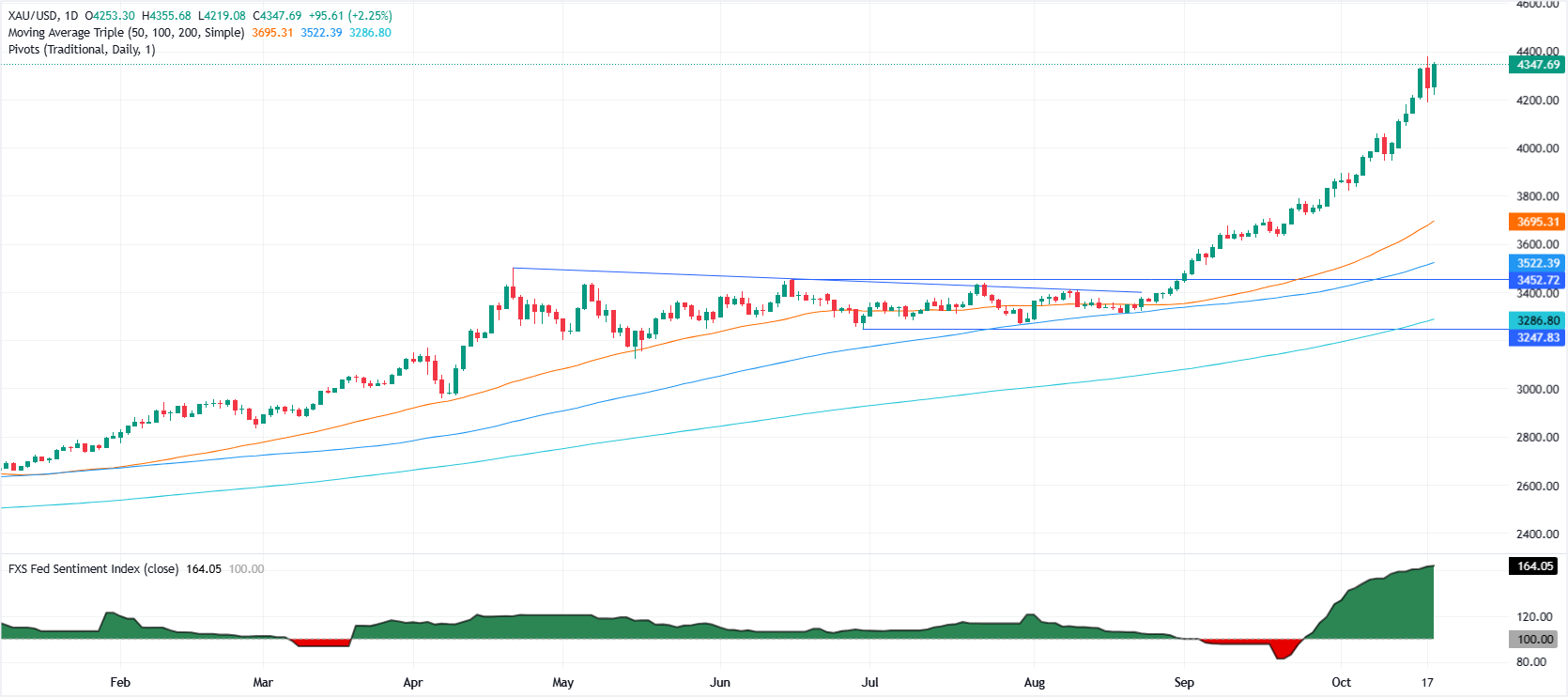Gold soars 2% as Fed cut bets deepen, US Dollar softens
- Gold buying renewed by a soft US Dollar and falling Treasury yields.
- Markets price in 96% odds of a Fed rate cut and 50 bps of total easing through year-end.
- Trade talks to resume in Malaysia as Trump presses China on fentanyl and soybean purchases.
Gold price rallies over 2% on Monday and trims last Friday’s losses on speculation that the Federal Reserve (Fed) will continue its easing cycle next week. A softer Greenback and falling US Treasury yields keep XAU/USD trading at $4,345 after hitting a daily low of $4,219.
XAU/USD rallies past $4,300 with traders eyeing next week’s Fed decision and US inflation data
The improvement in risk appetite due to US President Donald Trump tempering his comments on China was not excuse for Bullion to extend its uptrend amid a scarce economic docket in the United States. The US government shutdown entered its twentieth day, showing no signs of a reopening soon. This and Federal Reserve officials on a blackout period, leaves traders adrift to comments of Trump.
Later this week, the US Bureau of Labor Statistics (BLS) will release the US Consumer Price Index (CPI) for September, which will be scrutinized by traders and Fed officials, set to reveal their monetary policy decision, next week.
Market participants had priced in a 96% chance of the US central bank cutting rates and 50 bps for the rest of 2025.
Trade talks between Washington and Beijing will resume in Malaysia with the November 10 trade truce deadline looming. Trump listing top demands on China, like stopping fentanyl and resuming soybean purchases.
Daily market movers: Gold traders eyeing Trump comments, US-China talks
- Bullion prices are undermined as the US Dollar stages a comeback. The US Dollar Index (DXY), which tracks the performance of the buck’s value against a basket of six currencies, slides 0.06% to 98.60.
- Conversely, the US 10-year Treasury note yield is down two basis points at 3.991%. US real yields — which correlate inversely to Gold prices — are also steady at 1.723%, down nearly two basis points.
- Besides the release of US CPI figures during the week, traders will eye S&P Global Purchasing Managers Indices (PMI) prints for October.
- Geopolitics is also driving Bullion’s price action. Hostilities between Israel and Hamas, resumed in the Gaza Strip, as Israel launched airstrikes as retaliation of alleged overnight ceasefire violations by Hamas, threatening to end the peace deal, signed recently.
- The US Senate is expected to vote again on the US government re-opening on Monday as Senators return to Washington.
- XAU/USD has surged more than 62% in 2025, driven by geopolitical tensions, central bank buying and a de-dollarization trend. Also, flows into Gold ETF’s lifted Gold price from its yearly opening price of $2,623.
Technical outlook: Gold’s remains bullish as bulls target $4,350
Gold price uptrend remains intact, though buyers remain shy of conquering the $4,350 figure. A daily close above the latter will clear the path to test the all-time high at $4,379, ahead of $4,400 and the $4,500 print.
Conversely, if sellers drive price action below $4,200, this clears the path to challenge lower prices. The first support would be the October 17 daily low of $4,185, followed by the October 8 high previous record high at $4,059.

Gold FAQs
Gold has played a key role in human’s history as it has been widely used as a store of value and medium of exchange. Currently, apart from its shine and usage for jewelry, the precious metal is widely seen as a safe-haven asset, meaning that it is considered a good investment during turbulent times. Gold is also widely seen as a hedge against inflation and against depreciating currencies as it doesn’t rely on any specific issuer or government.
Central banks are the biggest Gold holders. In their aim to support their currencies in turbulent times, central banks tend to diversify their reserves and buy Gold to improve the perceived strength of the economy and the currency. High Gold reserves can be a source of trust for a country’s solvency. Central banks added 1,136 tonnes of Gold worth around $70 billion to their reserves in 2022, according to data from the World Gold Council. This is the highest yearly purchase since records began. Central banks from emerging economies such as China, India and Turkey are quickly increasing their Gold reserves.
Gold has an inverse correlation with the US Dollar and US Treasuries, which are both major reserve and safe-haven assets. When the Dollar depreciates, Gold tends to rise, enabling investors and central banks to diversify their assets in turbulent times. Gold is also inversely correlated with risk assets. A rally in the stock market tends to weaken Gold price, while sell-offs in riskier markets tend to favor the precious metal.
The price can move due to a wide range of factors. Geopolitical instability or fears of a deep recession can quickly make Gold price escalate due to its safe-haven status. As a yield-less asset, Gold tends to rise with lower interest rates, while higher cost of money usually weighs down on the yellow metal. Still, most moves depend on how the US Dollar (USD) behaves as the asset is priced in dollars (XAU/USD). A strong Dollar tends to keep the price of Gold controlled, whereas a weaker Dollar is likely to push Gold prices up.

